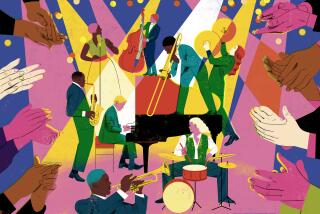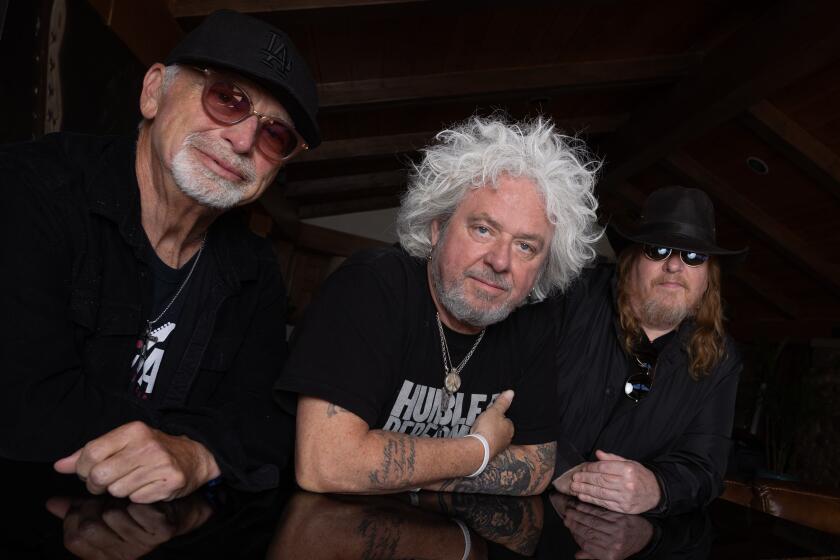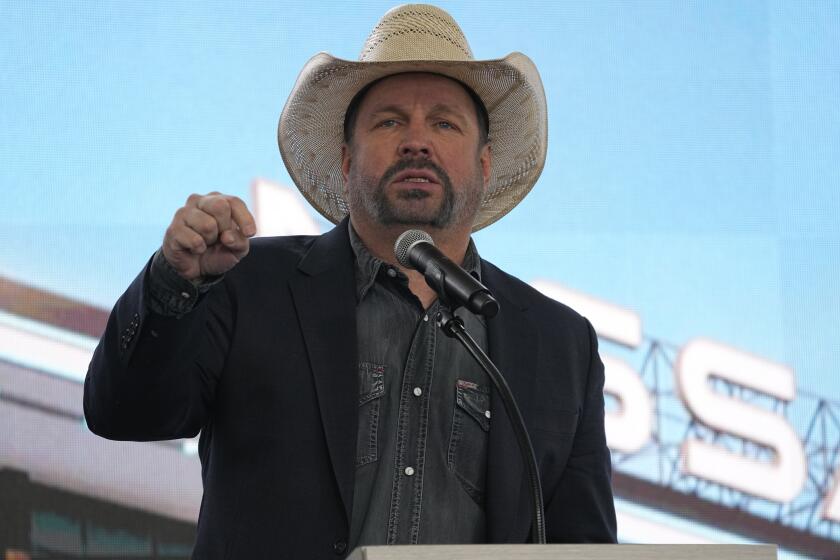AND ITS RECORDS AND T-SHIRTS, AS WELL : JAMES HARMAN BAND SELLS ITSELF ON THE ROAD
WICHITA, Kan. — In the world of rock ‘n’ roll there are essentially two reasons for an act to tour: self-promotion and to make money. Naturally, all aspiring bands hope to achieve both when they undertake a tour away from their home turf.
Singer James Harman, however, is a pragmatist who planned the James Harman Band’s first extensive visit to the Midwest primarily as a career move, since the Orange County blues-rock-R&B; group is popular enough locally to earn a decent living playing the Southern California club circuit.
But as the group’s business manager, as well as its lead singer, mouth harpist and front man, Harman desires more than just monetary success. In attempting to solidify and expand the group’s following outside of Orange County, the Alabama-born musician’s main financial goal for the tour was not to post a tremendous profit, but just to break even.
That the trip has been modestly profitable so far is attributable to the band members’ collective years of experience in addition to a few sharp business maneuvers.
In more ways than one, a large part of that success can be credited to independent Midwest concert promoter Gregory J. Stokesbury, who booked and promoted a majority of the 16 dates in 10 Western and Midwestern states.
Standing 6-foot-3 and weighing in at 375 pounds, Gregory J., as he prefers to be called, would be a big part of any project. Harman band guitarist Hollywood Fats, whose nickname reflects his own rotund physique, wisecracked, “Gregory J. is the one guy even I can call ‘Fats.’ ”
Comments Harman, “I wish I had a Gregory J. in every area we go to.” In advance of the band’s first show April 2 in Oklahoma City as well as for their dates in Nebraska, Iowa, Missouri, Kansas and Colorado, Gregory J. and his Airborne Talent agency of Cedar Rapids, Iowa, have handled the bookings, hotel reservations, local promotion with newspapers, radio stations and record stores and miscellaneous detail work that would otherwise fall on Harman.
With a territory extending from Minneapolis to Texas and Illinois to Utah, Gregory J. specializes in what he calls “blue wave” groups like the Harman band--acts whose music is blues-based but does not rigidly adhere to traditional blues styles.
Displaying a charm and wit to match his considerable girth, Gregory J. said, “Promoting tours with these bands is like dating a woman. You can either try just to get a one-night stand out of it, or you can send them flowers, take them to dinner and treat them with respect so that they’ll want to see you again.
“I think these guys have a real chance of breaking out like Los Lobos and I’d like to build them into one of my cornerstone acts in this region.”
The effort has been paying off with club owners, most of whom eagerly invited the band back.
After listening to Harman at the Lone Star club in Kansas City, booking agent Roger Naber said, “Along with the Nighthawks (from Washington, D.C.), I think these guys are one of the two best white blues bands in the country.”
Harman is already mapping out a return trip to the Midwest in July to capitalize on the momentum the group is generating on this visit. His philosophy about touring, he said, “is the same as with a tune or a solo: Make it long enough to say something and short enough to keep people interested.”
Harman also credits other roots music bands for spreading the word about their peers. “People like the Blasters, Los Lobos and the Mighty Flyers have been great about mentioning us when they play these places and we tell our audiences about them. That helps a lot.”
Since Harman reclaimed control over his band’s bookings from an outside agent earlier this year, he has been selecting shows more carefully, accepting only those that he considers strategically important.
He’s also picked up the slack in some other areas. For instance, even though the group’s 1983 “Thank You Baby” mini-LP was an excellent showcase for the band’s versatility, Harman believes that local independent label Enigma Records dropped the ball when it came to promotion and distribution.
“A lot of the stores out here never even saw the record until Gregory J. brought some in,” said Harman, who also brought several cases of records with the band to sell at the shows along with promotional T-shirts. Harman said record and T-shirt sales have added $100 to $150 to each night’s take and the small crowd at Wichita’s 50-year-old Coyote Club Wednesday night bought about $170 worth of goods.
“The name of the game is promotion and merchandising. A group like Journey will play the Forum and make $90,000 a night on ticket sales and another $120,000 on T-shirts, beanies, lunch boxes and all that other stuff. If we can make enough on T-shirts just to pay for hotel rooms, then that’s one less thing we have to pay for out of our pockets.”
If it sounds like the band members are becoming more salesmen than musicians, Harman explained, “The more money you make, the more freedom you have to do more things. Like anything else, you have to do what you do and believe in it. If the music is supposedly already good, then you still have to market it to get people to hear it. It’s a business.”
Though it’s giving the band valuable exposure, the hectic one-night-per-town pace of this tour is highly stressful, both for the five musicians and for roadies Steve (Thang) Groene and John (Mongoose) Workman, who are paid $40 a night each to set up and break down the stage equipment at every show.
In Wichita, the band’s ninth show in nine nights since Oklahoma City, Harman battled a rapidly deteriorating voice all night. Even though the audience responded enthusiastically, Harman was clearly frustrated.
“It would really help if I could take about every fourth or fifth day off,” he said. “I confess it’s that old fear of not meeting expenses and knowing that each night we don’t play will cost us $200 or $300.
“When you’re 18, 19, 20 years old and have no responsibility, it’s a lot easier. You don’t have to worry about having a wife at home and a kid on the way like I do.” Harman’s wife, Ella, is due with their first child in May. Drummer Stephen Hodges, the only other member of the band who is married, has two children.
“But when you’re younger,” Harman added, “you don’t know anything either. It’s the old trade-off that ‘If I only knew then what I know now.’ ”
The group’s next move will be the release of two new albums this year. One will be a half-live, half-studio album of straight blues. The other will be a more pop-oriented follow-up to “Thank You Baby.”
Again, doing two albums aimed at different markets is part of the group’s long-range strategy. “The blues record will be good for this area (the Midwest blues circuit),” Harman said. “Once all the blues freaks buy that, they’ll be more likely to buy the other album.”
Having rebounded from the demise of his mid-1970s Ice House Blues Band, Harman is determined not to let anything stand in the way of success this time around. He’s particularly proud of the current lineup, which came together over a period of about seven years. Working as a full-time musical unit for more than three years now, Harman, Hodges, Fats, guitarist Kid Ramos and bassist Willie J. Campbell have developed into one of the liveliest and most thoroughly invigorating bands in the state.
But no matter how good a group’s music is, it is the career decisions that usually divide the winners from the also-rans. “I know bands that are still out there getting $250 a night from the same clubs they’ve been playing for seven years,” Harman said. “They never move beyond that level.”
For the shot at winning new fans in the Midwest, the Harman band chose to work for smaller guarantees than it commands in Southern California.
But to the band members’ satisfaction, they have been drawing large enough crowds at most of the shows that percentage options in their contracts are bringing their nightly takes closer to what they are used to getting at home, which is anywhere from $750 to $1,000 a night or more. Because of the good turnouts on the band’s first visit, the financial terms of future contracts will be substantially improved.
None of this would have happened, however, if the group hadn’t decided to risk the security of playing endlessly around Southern California against the unknown quantity of a tour to new areas.
To Harman, though, there was never really a question about whether to take the gamble.
“You’ve got to branch out and take a chance. You’ve got to take risks,” he said. Feigning a fast-draw, shoot-from-the-hip gesture, Harman said, “That’s what this life’s all about, isn’t it?”
More to Read
The biggest entertainment stories
Get our big stories about Hollywood, film, television, music, arts, culture and more right in your inbox as soon as they publish.
You may occasionally receive promotional content from the Los Angeles Times.










